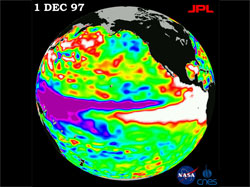
Physical Feature: Ocean Productivity

This image of the Pacific Ocean was produced using sea surface height measurements taken by the U.S./French TOPEX/Poseidon satellite. The image shows sea surface height relative to normal ocean conditions on Dec. 1, 1997. In this image, the white and red areas indicate unusual patterns of heat storage; in the white areas, the sea surface is between 14 and 32 centimeters (6 to 13 inches) above normal; in the red areas, it's about 10 centimeters (4 inches) above normal. The green areas indicate normal conditions, while purple (the western Pacific) means at least 18 centimeters (7 inches) below normal sea level.
In the Northwestern Hawaiian Islands ocean productivity has been linked to large scale fluctuations in sea surface temperature and related oceanographic and atmospheric conditions. The most widely known of these fluctuations are El Niño and La Niña. During El Niño warmer, nutrient poor waters from the Western tropical Pacific move East and replace cooler nutrient rich waters off the coast of South America. During La Niña the reverse occurs. These large-scale fluctuations are part of the Earth's temperature regulation mechanisms, and have global effects on rainfall, climate, and ocean productivity. The rise and fall of many civilizations around the world have had ties to these climactic phenomena – the decline of the Inca in Peru, and lower crop yields in France during a strong El Niño in 1789-1793 may have ignited the French Revolution. Around Hawai'i an additional, but less well known climactic variability is the Pacific Decadal Oscillation, or PDO. This is a longer-term shift in sea surface temperature, occurring every 20 to 30 years rather than the roughly five year flux of El Niño/ La Niña. When the waters around the NWHI are warmer they are less productive, and wildlife such as monk seals and seabirds have a harder time finding food and populations decline. One of the current challenges to monk seal recovery in the NWHI is thought to relate to prey availability, and this may be partially due to a low productivity cycle of the PDO.
